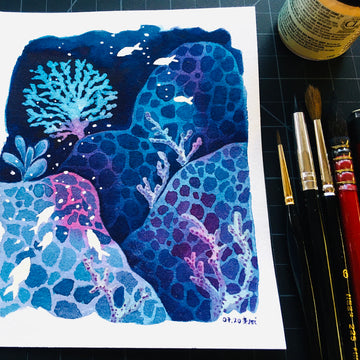Ah, masking fluid. Also known as liquid frisket, this is a tool used in the watercolour world to keep the paper underneath from being painted.
Often used to preserve the white of the paper, it’s considered a bit of a tool of convenience, but can also be useful in certain situations.
A “Resisting” Technique
Masking fluid is considered a “watercolour resist” technique, alongside things like masking/artist’s tape and a simple wax crayon. It works by creating a layer of latex on the paper’s surface, and is peeled away once dry.
This means that unlike the wax crayon, masking fluid is much better at preserving cleaner and more unusual shapes on the page, without leaving behind its own texture. A pretty neat invention!
How to Use Masking Fluid

There are a few kinds of masking fluid, but the one I like is tinted with orange, which makes it easier to see where I’m placing it. Make sure to give it a good shake each time before using!
Depending on how long you’ll be using it, you might need to pour out a little in a small container before recapping the main bottle, as masking fluid can and will dry up very quickly.
Bonus tip: Store the bottle upside-down, as the fluid inside will slowly evaporate even when in an airtight container!
As for applying masking fluid, I know some watercolourists like to use a synthetic paintbrush dipped in a little soap. This is because masking fluid dries pretty quickly, and can easily clog up the bristles and ruin the brush’s tip, even after cleaning it.
The soap acts as a protective boundary here, though it’s a bit of a balancing act to get the right amount of soap without having the masking liquid slide around your brush.
A great alternative is a flexible stick of plastic, silicone, or rubber. I use a pointed rubber brush that’s actually made for sculpting clay, but the solid tip makes it perfect for applying masking fluid in small areas–plus it's really easy to clean.
Finally, if you really want to, you can skip all the hassle and get the pen-type masking fluid, though it will cost more than a regular bottle.
Whichever method you choose, just remember to make sure the masking fluid is completely dry before painting on top, and that the paint is dry before peeling off the masking fluid.
It should come off by rubbing it off with your fingers, or using a rubber cement pickup.
Also, don’t apply too thick of a layer or leave it on for too long, as it could remove the surface layer of your paper, or stain the white underneath if you’re using the tinted version.
“But can’t I just not use masking fluid, and paint around the area I want to keep white?”
Well, technically, yes. If the area you’re avoiding is relatively large, or if you have good brush and water control, then it’s often better to go without the masking fluid. So when would be the best time to use it?
1. For Small Areas

One great use would be when the white parts are too small or finicky to easily paint around. Or maybe there’s a cluster of highlights that would be too tedious to try to avoid, such as these bubbles and fish in the image above.
With masking fluid protecting your whites, you can simply paint over the whole paper, and peel the masking fluid off later to reveal perfectly white highlights.
Of course, you could also use a white gel pen or gouache paint to add these dots in later, which is fine for pure white details, but won’t work if you’re planning to layer paint on top.
2. For Funky But Precise Shapes

If the area you need to mask is a very specific but irregular shape, then masking fluid can be used to simplify the process.
For example, in the painting above, I wanted to keep the coral the same light colours found in the first layer.
To do this I masked the coral, painted the background spots on the rocks, then went back in to paint the corals’ details after peeling off the mask.
3. For Negative Painting

The final and most advanced use for masking fluid would be for negative painting (i.e. painting the areas around the subject to define it).
While most uses for masking fluid are to preserve the white of the paper, you can also apply it on top of painted layers to keep those colours while adding another layer of colour on top.
You have to be careful though – you could accidentally peel off a bit of paint, especially if the masking fluid has been left to sit for too long, or if you applied too thick of a layer.
Final Thoughts
In any case, masking fluid makes watercolouring a bit easier, especially if your art style uses a lot of detailed highlights or negative painting techniques.
It might not be for everyone, but it’s still good to know that there’s an option other than having to paint around everything! And as always, the best way to know if you like something for sure is to try it out for yourself.
Do you use masking fluid in your watercolour work? What are your own takeaways from using masking fluid? Let us know in the comments below!


